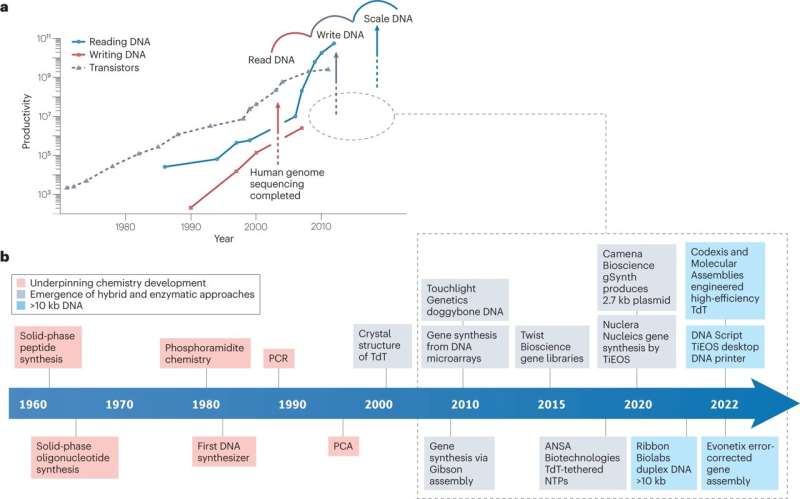
NPL, in collaboration with London Biofoundry and BiologIC Technologies Ltd, have released an analysis on existing and emerging DNA Synthesis technologies in Nature Reviews Chemistry, featuring the work on the front cover.
The study, which was initiated by DSTL, set out to understand the development trajectory of DNA Synthesis as a major industry drive for the UK economy over the next 10 years. The demand for synthetic DNA is growing exponentially. However, our ability to make, or write, DNA lags behind our ability to sequence, or read, it. The study reviewed existing and emerging DNA synthesis technologies developed to close this gene writing gap.
DNA or genes provide a universal tool to engineer and manipulate living systems. Recent progress in DNA synthesis has brought up limitless possibilities in a variety of industry sectors. Engineering biology, therapy and diagnostics, data storage, defense and nanotechnology are all set for unprecedented breakthroughs if DNA can be provided at scale and low cost.
As an example, DNA has already been used to write books, episodes of Netflix series, video games and is being applied to catalog the entire British Library. Just one gram of DNA is estimated to store over 17 Exabytes of information, whereas 5 Exabytes is all that is needed to store all the words spoken by mankind.
The review details DNA chemistry, cross-compares the efficacies of synthesis technologies, outlines pros and cons of commercialized techniques versus future optimisations, and discusses oversight, security, deskilling, automation, and standardization of DNA synthesis.
The review identified common trends and dependences in DNA synthesis technologies, as well as leading companies who develop innovative solutions to circumvent current limitations. With existing technologies, it is now possible to make large DNA molecules and many DNA molecules simultaneously on tiny microchips.
As DNA synthesis becomes affordable, there are many options available from industry, from customized DNA synthesis to benchtop DNA printers allowing non-expert users themselves to make DNA. However, much remains to be addressed before we can reach the ability to make full sized genes and genomes and thereby close the gene writing gap.
Max Ryadnov, NPL Fellow, said, “Among other challenges, the development of robust metrology and suitable standards are required to accelerate and safeguard the uptake of synthetic DNA by the end users. Of particular relevance this is for the UK’s National Engineering Biology program, designed to build on the UK’s capabilities to boost businesses and commercialisation of enabling technologies. NPL supports this endeavor by developing a toolbox of traceable reference materials, methods and standards, which will underpin further developments in the field.”
More information: Alex Hoose et al, DNA synthesis technologies to close the gene writing gap, Nature Reviews Chemistry (2023). DOI: 10.1038/s41570-022-00456-9
Provided by National Physical Laboratory

